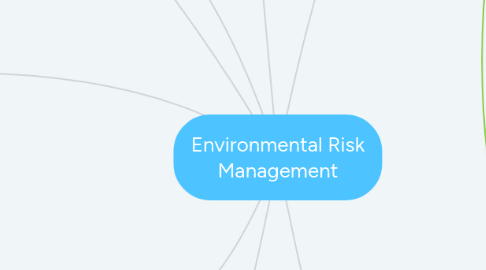
1. Determine probability of hazard occurence
2. Market Based Intruments
2.1. Effluent Taxes
2.1.1. Tax needs to be large in order to deter organizations
2.1.2. Can also be a non compliance fee for people who use too much (ie. only kicks in when you exceed a threshold of pollution)
2.1.3. Widely used in Europe
2.1.4. Ie. Carbon Taxes and Bag Tags
2.2. Subsidies
2.2.1. A payment for complying
2.2.2. If nobody is collecting the subsidy you have to bring it up
2.3. Tradable Permits
2.3.1. The holder is a company or jurisdiction and it is initially distributed free of charge defining the amount of emissions and then these can be auctioned between emitters
2.3.2. with the permits you don't need you can sell or trade them so it becomes revenue for the company
2.3.3. Price is based on market vaue
2.3.4. Permit trading cannot be used for substances for which the only acceptable emission level is 0
2.3.5. Permit trading assumes perfect competition which never exists in a free market
2.3.6. Types include cap & trade, baseline emission reduction (companies make their own forecast), rate-based emissions trading (ie. Connective you can only buy permits from up-wind, and want to be close enough)
2.3.7. Conditions for effective permit trading are: cost of pollution varies between sources, pollutants tend to mix a great deal, transaction costs are low
2.4. Bubbles
2.4.1. Allows to make credits at a lower cost
2.4.2. Made at an international level in the Kyoto Protocol
2.4.2.1. EU wanted to be seen as a bubble and agreed to collective 8% reduction of their 1990 overall EU emission which gave them an advantage because some countries were able to have a big reduction while some weren't
2.5. Offsets
2.5.1. Emission credit given for engaging in activities that counteract the effects of pollution at home
2.5.2. It is cheaper to buy offsets than to make changes at home
2.5.3. Ie. forest sinks and carbon
2.6. Suasive Instruments
3. Regulatory Instruments
3.1. Standards
3.2. Enforcement
3.2.1. Leads to activities with impacts to be prohibited, restricted through quantitative standards establishing level limits, allowed through licensing or permits
3.3. Advantages
3.3.1. Quick in reducing pollution
3.3.2. provides polluters with predictable requirements they must need
3.3.3. cost-effective to administer
3.3.4. equitable
3.3.5. immune from political interference
3.4. Disadvantages
3.4.1. Don't take local conditions into account
3.4.2. no incentive to pollute less than what is permitted
3.4.3. Do not allow polluters to reduce emissions in a cost-effective way
3.4.4. Penalties for non-compliance are too lenient

